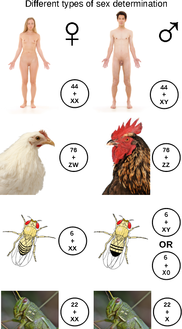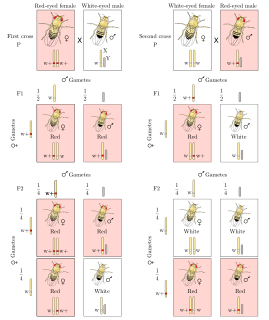A metafemale (or superfemale) is a low viability Drosophila fruit fly with a female phenotype in which the ratio of X chromosomes to sets of autosomes (A) exceeds 1.0. [1] For example: a fly with one X chromosome and two sets of autosomes is a normal male, a fly with two X chromosomes and two sets of autosomes is a normal female, and a fly with three X chromosomes and two sets of autosomes (or four X chromosomes and three sets of autosomes) is a metafemale.

Drosophila is a genus of flies, belonging to the family Drosophilidae, whose members are often called "small fruit flies" or pomace flies, vinegar flies, or wine flies, a reference to the characteristic of many species to linger around overripe or rotting fruit. They should not be confused with the Tephritidae, a related family, which are also called fruit flies ; tephritids feed primarily on unripe or ripe fruit, with many species being regarded as destructive agricultural pests, especially the Mediterranean fruit fly. One species of Drosophila in particular, D. melanogaster, has been heavily used in research in genetics and is a common model organism in developmental biology. The terms "fruit fly" and "Drosophila" are often used synonymously with D. melanogaster in modern biological literature. The entire genus, however, contains more than 1,500 species and is very diverse in appearance, behavior, and breeding habitat.

The phenotype of an organism is the composite of the organism's observable characteristics or traits, including its morphology or physical form and structure; its developmental processes; its biochemical and physiological properties; its behavior, and the products of behavior, for example, a bird's nest. An organism's phenotype results from two basic factors: the expression of an organism's genetic code, or its genotype, and the influence of environmental factors, which may interact, further affecting phenotype. When two or more clearly different phenotypes exist in the same population of a species, the species is called polymorphic. A well-documented polymorphism is Labrador Retriever coloring; while the coat color depends on many genes, it is clearly seen in the environment as yellow, black and brown. Richard Dawkins in 1978 and then again in his 1982 book The Extended Phenotype suggested that bird nests and other built structures such as caddis fly larvae cases and beaver dams can be considered as "extended phenotypes".

An autosome is a chromosome that is not an allosome. The members of an autosome pair in a diploid cell have the same morphology, unlike those in allosome pairs which may have different structures. The DNA in autosomes is collectively known as atDNA or auDNA.
American geneticist Calvin Bridges, who discovered the genic balance sex-determination system in Drosophila in 1921, used the terms "superfemale" and "supermale". [2] German-American geneticist Curt Stern proposed the alternative terms "metafemale" and "metamale" in 1959. [3]
Calvin Blackman Bridges was an American scientist known for his contributions to the field of genetics. Along with Alfred Sturtevant and H.J. Muller, Bridges was part of Thomas Hunt Morgan's famous "Fly Room" at Columbia University.

A sex-determination system is a biological system that determines the development of sexual characteristics in an organism. Most organisms that create their offspring using sexual reproduction have two sexes. Occasionally, there are hermaphrodites in place of one or both sexes. There are also some species that are only one sex due to parthenogenesis, the act of a female reproducing without fertilization.
Curt Stern was a German-born American geneticist.










